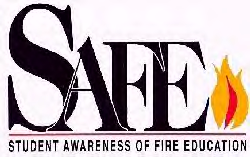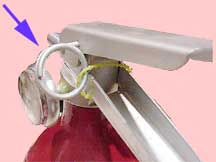

|
Facts About Carbon Monoxide
|
||||||||||||||||||
|
||||||||||||||||||
Fire Extinguisher Tips
|
Choosing a Portable Fire Extinguisher
|
|
Symbol on Fire
Extinguisher
|
Description of materials
extinguished by respective Class of Extinguisher.
|

|
Class A: Ordinary combustibles such as wood, cloth, paper, rubber, and many plastics... (material that produces Ashes) |

|
Class B: Flammable liquids such as gasoline, oil, grease, tar, oil-based paint, solvents, lacquer, and flammable gas... (remember that liquids Boil) |

|
Class C: Energized electrical equipment including wiring, fuse boxes, circuit breakers, machinery, and appliances... (anything that carries an electric Charge) |

|
Class D: Combustible metals such as magnesium, titanium, or sodium. These types of fire are very dangerous and seldom handled by the general public... (in other words, Don't mess with it!) |
|
Fire extinguishers also have a number rating. For Type A fires, a 1 would stand for 1 1/4 gallons of water, a 2 would represent 2 1/2 gallons, 3 would be 3 3/4 gallons of water, etc. For Type B and Type C fire, the number represents square feet covered by the extinguisher. For example, 2 would be two square feet, 5 is five square feet, etc. Fire extinguishers are also made to extinguish more than one type of fire. For example, you might have an extinguisher with a label that reads 2A5B. This would mean this extinguisher is good for Type A fires with a 2 1/2 gallon equivalence and it is also good for Type B fires with a 5 square feet equivalency. A good extinguisher to have in each residential kitchen is a 2A10BC fire extinguisher. You might also get a Type A for the living room and bedrooms and an ABC for the basement and garage. Some portable extinguishers will show multiple labels with one or more of the labels crossed out with a line. These are only to be used for those types of fires indicated by labels that do not have a line through them. |
|
Types of Extinguishers
NOTE: there are other specialty extinguishers that are available in specific locations for special hazards. These extinguishers include:
|
|
Portable extinguishers should be installed within plain view and out of the reach of children. They should be near an escape route and always away from stoves and other heat sources. |
|
|
Check your extinguisher gauge every month, making sure the needle is always in the green section of the gauge. If it is not, replace it or have it recharged. It is extremely important that the pin is always kept in the handle and only pulled out just before use. NOTE: Some pins are metal and others are plastic. |


|
|
Alternate heating devices are the leading cause of fire deaths in the Southeastern U.S. The elderly and small children are the most vulnerable.
|
|
|
For additional information, please contact Chief Pete Oakley or Asst. Chief Glen Storie At (413)-443-2321. |
![]() 1. Install Smoke Detectors.
1. Install Smoke Detectors.
WORKING SMOKE DETECTORS can alert you to a fire in your home in time for you to escape, even if you are sleeping. Install smoke detectors on every level of your home, including the basement, and outside each sleeping area. If you sleep with the door closed, install one inside your sleeping area as well.
Test detectors every month, following the manufacturer's directions, and replace batteries once a year, or whenever a detector "chirps" to signal low battery power. Never "borrow" a smoke detector's battery for another use - a disabled detector can't save your life. Replace detectors that are more than 10 years old.
![]() 2.
Plan Your Escape From Fire.
2.
Plan Your Escape From Fire.
IF A FIRE BREAKS OUT in your home, you have to get out fast. Prepare for a fire emergency by sitting down with your family and agreeing on an escape plan. Be sure that everyone knows at least two unobstructed exits - doors and windows - from every room. (If you live in an apartment building, do not include elevators in your escape plan.) Decide on a meeting place outside where everyone will meet after they escape. Have your entire household practice your escape plan at least twice a year.
![]() 3. Keep An Eye
On Smokers.
3. Keep An Eye
On Smokers.
Careless smoking is the leading cause of fire deaths in North America. Smoking in bed or when you are drowsy could be deadly. Provide smokers with large, deep non-tip ashtrays and soak butts with water before discarding them. Before going to bed or leaving home after someone has been smoking, check under and around cushions and upholstered furniture for smoldering cigarettes.
![]() 4. Cook Carefully.
4. Cook Carefully.
Never leave cooking unattended. Keep cooking areas clear of combustibles and wear clothes with short, rolled-up or tight-fitting sleeves when you cook. Turn pot handles inward on the stove where you can't bump them and children can't grab them. Enforce a "Kid-Free Zone" three feet (one meter) around your kitchen stove. If grease catches fire in a pan, slide a lid over the pan to smother the flames and turn off the heat. Leave the lid on until cool.
![]() 5. Give Space Heaters Space.
5. Give Space Heaters Space.
Keep portable heaters and space heaters at least three feet (one meter) from anything that can burn. keep children and pets away from heaters, and never leave heaters on when you leave home or go to bed.
![]() 6. Remember:
Matches & Lighters Are Tools, Not Toys.
6. Remember:
Matches & Lighters Are Tools, Not Toys.
In a child's hand, matches and lighters can be deadly. Use only child-resistant lighters and store all matches and lighters up high, where small children can't see or reach them, preferably in a locked cabinet. Teach your children that matches and lighters are tools, not toys, and should be used only by adults or with adult supervision. Teach young children to tell a grown-up if they find matches or lighters; older children should bring matches or lighters to an adult immediately.
![]() 7. Cool A Burn.
7. Cool A Burn.
Run cool water over a burn for 10 to 15 minutes. Never put butter or any grease on a burn. If the burned skin blisters or is charred, see a doctor immediately. Never use ice.
![]() 8. Use Electricity Safely.
8. Use Electricity Safely.
If an electrical appliance smokes or has an unusual smell, unplug it immediately, then have it serviced before using it again. Replace any electrical cord that is cracked or frayed. Don't overload extension cords or run them under rugs. Don't' tamper with your fuse box or use improper-size fuses.
![]() 9. Crawl Low Under Smoke.
9. Crawl Low Under Smoke.
During a fire, smoke and poisonous gases rise with the heat. The air is cleaner near the floor. If you encounter smoke while you are escaping from a fire, use an alternate escape route.
![]()
If your clothes catch fire, don't run. Stop where you are, drop to the ground, cover your face with your hands, and roll over and over to smother the flames.